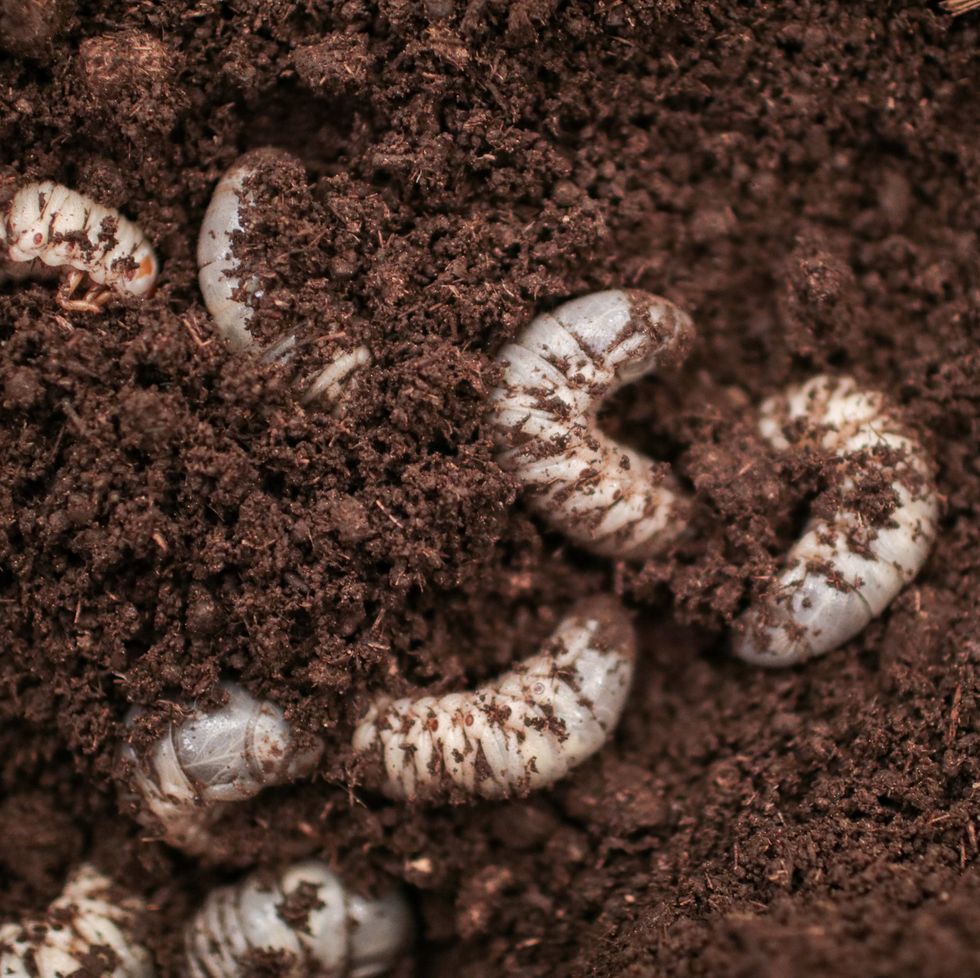Are June Bugs Dangerous? What Experts Want You to Know Before Beetle Season

[ad_1]
Our gardens and flowering pots spring again to life all through April and May — however their arrival alerts that “June” bugs are quickly to observe. Many owners can’t assist however discover a myriad of shiny beetles buzzing round their favourite planting beds, seasonal mulch or worse but, flying round close to the entryways of your private home (similar to mosquitos!). While they’re not notably harmful to your well being, June bugs are certainly a hazard for most of the vegetation, flowers and yard crops you might be planting proper now for the summer season season.
Calling them June bugs is a reference to a colloquial time period, specialists say, as there are literally effectively over 200 completely different species of bugs throughout North America. “June” bugs could go by completely different nicknames in numerous U.S. areas, “however they typically get this moniker as a result of the adults are generally seen rising in late Spring — often, in May or June,” explains Avery Russell, Ph.D., assistant professor of biology at Missouri State University.
Whether you name them May-June beetles or screen-thumpers, these massive pests are sometimes seen gathering round exterior lights as the primary signal they’ve chosen to settle in your personal yard. What different warning indicators could clue you into an infestation, you might ask? Read on to study extra about June bugs’ menace to gardens, how they work together with your loved ones, and learn how to eliminate them in accordance with pest specialists in academia in addition to business pest removing.
What are June bugs — and what precisely do they do?
These pests are method too massive so that you can miss, and embody widespread variations of Japanese beetles and European chafers, in accordance with horticulture data revealed by the University of Wisconsin-Madison. They’re additionally generally known as scarab beetles — however there’s likelihood them as “May” bugs should you’re positioned in a area the place temperatures are larger this month than these within the Northeast or Pacific Northwest.
“They’re most likely most identified for crashing into home windows and screens at evening should you go away the sunshine on,” explains David Coyle, Ph.D., assistant professor of forest well being and invasive species at Clemson University. “The larval type — or younger — of those bugs is named a white grub; should you’ve ever been digging within the backyard and seen a ‘C’-shaped white grub within the spring and early summer season, that’s most likely a younger June bug.”
June bugs can vary in coloration, often a shade of sunshine brown or darkish brown; every beetle-like bug has six legs that comprise hair-like protrusions, as most different beetles do.
“Most of us can establish a June bug as a brown beetle that usually can startle an individual by flying into their face or hair,” explains Megan Wede, a pest management specialist, advertising lead and co-owner of Minnesota-based Done Right Pest Solutions. “Pets typically eat them in the event that they turn into a nuisance to the pet.”
Regardless of which stage of life they’re at, June bugs can encroach in your backyard and the vegetation in and round your exterior areas (in addition to some indoor spots, too!). They’re identified to feast on the leaves of backyard vegetation, bushes and shrubbery; whereas they aren’t often capable of kill vegetation off totally till a serious infestation has fashioned, Wede says they will destroy the outward look and profile of lots of your leaves and flowers.
“There are many species of June bugs, a few of which might feed on backyard and panorama vegetation; in some circumstances, this feeding may be very extreme and injure, or kill vegetation,” Coyle provides. “Most species, nevertheless, are likely to feed on shrubs and bushes, and their feeding harm may be barely noticeable.”
Sometimes, June bugs catch the flack for the difficulty that bigger animals that hunt them — together with moles — deliver to your backyard. Usually, June bugs favor to munch on turfgrass, and might trigger massive patches of this grass to wither and die; they could additionally favor corn, roses and thin-skinned fruits along with the decorative vegetation they’re identified to gravitate in direction of, in accordance with supplies revealed by the University of Maine.
Can June bugs chew you? The actual hurt they pose:
While they will spell catastrophe for gardening perfectionists and purists, June bugs don’t pose any menace to people, together with kids. “Their jaws are weak and might pinch, used solely in protection,” Russell explains.
If you’ve heard of or have seen somebody battle with a June bug hooked up to their pores and skin, it’s doubtless as a result of these bugs have claws that “stick” to your fingers or palms, resulting in a ticklish impact — however nothing harmful, Coyle tells Good Housekeeping.
“June bugs don’t pose any menace to individuals or pets, and I’ve by no means identified anybody or something to be bitten by certainly one of these beetles,” he says. “In reality, scarab beetles are revered in historical Egyptian tradition as they have been seen as a logo of renewal and rebirth, which is why you see such a beetle featured on many historical artifacts.”
Additionally, June bugs received’t threaten the structural integrity of the interiors of your private home or its basis, so don’t sweat it if one follows you inside. They’re intensely interested in gentle, Wede says, and will get inside your private home by way of a gap in doorways or home windows at evening. “When this occurs, they’re — at most — annoying and thought of gross. But there’s no danger to 1’s residence structurally.”
Signs of a June bug infestation
While they arrive in early summer season within the type of larvae (or grubs!), most householders don’t understand their gardens or yards are being impacted by a June bug infestation till early fall when the climate tends to dry out. “Damage to leaves is usually minor and largely unnoticeable, however harm by the larvae to turfgrass is the very first thing many individuals discover, in useless grass patches,” Russell shares.
Because new child June bugs burrow underground in yards and gardens, you might discover that holes are being dug by predators, per the U.S. Department of Agriculture — however it is a uncommon prevalence. Lawn circumstances are sometimes the primary clue that you could be be coping with extreme June bugs in your property. Ultimately, nevertheless, motion will not be required.
“In pure landscapes, grubs are a typical element of the soil fauna throughout the nation. Their harm isn’t, if ever, observed,” advises Coyle, who provides that fungi and different causes could possibly be the basis explanation for impacted greenery. “Just since you see patches of garden dying doesn’t essentially imply you’ve a June bug downside… The first step is determining precisely what’s inflicting the harm you see.”
If you’re involved about holes and irregularities showing on flowering vegetation in your backyard resulting from June bugs, although, focused removing is usually your greatest guess for coping with them in the long term. You’ll want to begin by contacting a neighborhood Extension workplace in your space and talking with a consultant. “They’ll present you unbiased data and recommendation,” Coyle stresses.
How to eliminate June bugs
Once you’ve confirmed your backyard woes are certainly brought on by grownup June bugs or their larvae, you’ll must pursue a number of completely different methods to forestall common harm each season. Many pest management suppliers will suggest what’s often known as grub management, which means they’ll deal with lawns and backyard beds with chemical remedy — however these therapies ought to be a resort provided that a licensed supplier has confirmed larvae are current, as they are often extra harmful than you’d assume.
“Keep in thoughts these is not going to solely kill the June bug grub, however may also kill many different forms of soil fauna, a few of that are useful,” Coyle explains. “There are additionally useful nematodes that may be utilized in focused areas. These microscopic predatory worms search out and feed on June bug grubs.”
Otherwise, grownup June bugs could also be focused with gardening instruments that preserve them away from the vegetation they’ve been munching on, so to talk. Coyle says deterrent sprays — like neem oil — may be utilized to leaves and different downside areas as wanted. If you solely discover a swarm in a single space, grownup June bugs may be picked off one after the other and dropped right into a container of soapy water, which kills the bugs.
The season for June bugs is brief, and so they die off pretty rapidly, Wede says. You could discover success by turning to an electrical gentle that targets different flying bugs for mitigation, and even business beetle traps that may preserve June bugs from flying round. “You can put these out on the patio or deck so you possibly can benefit from the open air,” she provides.
The backside line: “One of the very best issues you are able to do is promote a various ecosystem in your property. Many forms of birds — like crows, robins, and blue jays — feed on grubs within the soil,” Coyle says. “Since birds are pure predators of grubs, doing issues that promote a wholesome hen inhabitants will assist preserve grub numbers underneath management.”
Health Editor
Zee Krstic is a well being editor for Good Housekeeping, the place he covers well being and vitamin information, decodes food regimen and health traits and opinions the very best merchandise within the wellness aisle. Prior to becoming a member of GH in 2019, Zee fostered a vitamin background as an editor at Cooking Light and is regularly growing his grasp of holistic well being by way of collaboration with main tutorial specialists and medical care suppliers. He has written about meals and eating for Time, amongst different publications.
Dr. Coyle, assistant professorof Forest Health and Invasive Species, joined Clemson University in 2018 with a deal with the forest well being and invasive species Extension. Prior to Clemson, he created and directed the Southern Forest Health and Invasive Species program, which offered schooling and coaching to forestry professionals throughout the southeastern U.S. Dr. Coyle makes use of numerous types of communication – together with social media, conventional writing, and in-person visits – to assist educate individuals about forest well being, invasive species, and forest administration. He is a member of the Society of American Foresters and the Entomological Society of America, serves on the Board of Directors for the North American Invasive Species Management Association, and is Co-Director of ProfessionalForest (a corporation working to advertise proactive forest pest administration).
[ad_2]
Source link



















Leave a comment